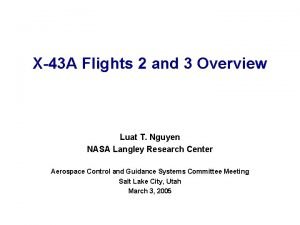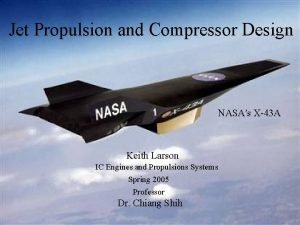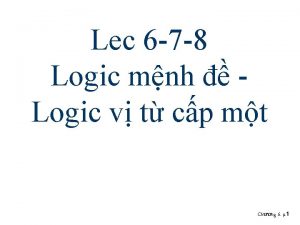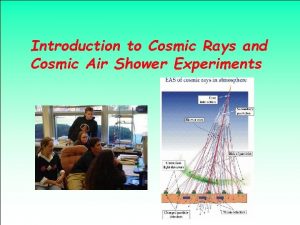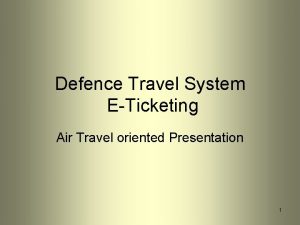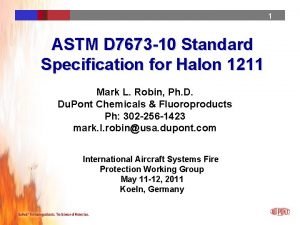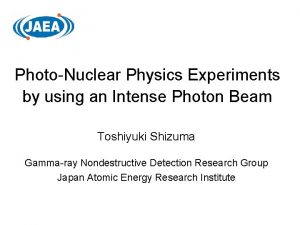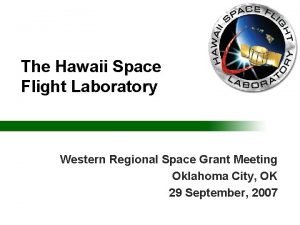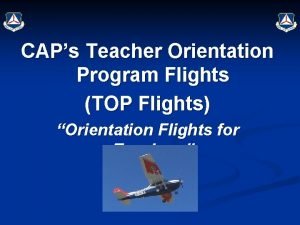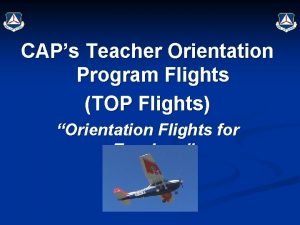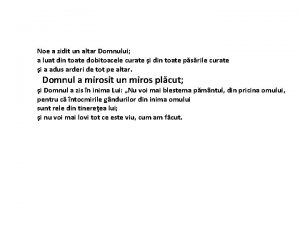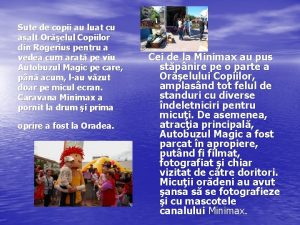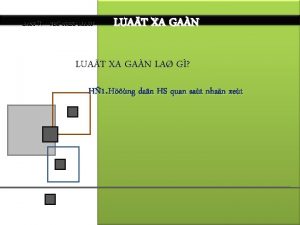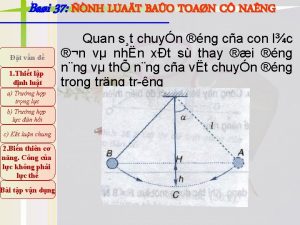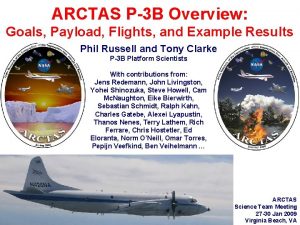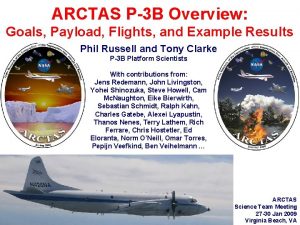X43 A Flights 2 and 3 Overview Luat

































- Slides: 33

X-43 A Flights 2 and 3 Overview Luat T. Nguyen NASA Langley Research Center Aerospace Control and Guidance Systems Committee Meeting Salt Lake City, Utah March 3, 2005

Background Air-Breathing Launch Systems Are More Efficient Air-Breathing Systems Possess Significantly Higher Propulsive Efficiency Hydrogen Fuel Hydrocarbon Fuels Turbojets Rocket Based Combined Cycle Specific Impulse Turbine Based Combined Cycle Ramjets Scramjets Turbojets Ramjets Scramjets Rockets 0 12002 -2707 10 MACH NUMBER 20 2

Goals/Objectives of Hyper-X Program GOALS: Demonstrate, validate and advance the technology, experimental techniques, and computational methods and tools for design and performance predictions of a hypersonic aircraft powered with an airframe-integrated, scramjet engine. FLIGHT OBJECTIVES: - Three flights: two @ Mach 7 and one Mach 10 - Methods verification - Scaling confirmation Primary Metric: Accelerate TECHNOLOGY OBJECTIVES: - Vehicle design & risk reduction - Flight validation of design methods - Design method enhancement - Hyper-X Phase 2 and beyond 12002 -2707 Comparison of Ground & Flight Data Wind Tunnel-to. Wind Tunnel Comparison 3

X-43 Vehicle Geometry 148" 60" Length: 12'4" (3. 7 meters) Width: 5'0" (1. 5 meters) Height: : 2'2" (0. 6 meters) Weight: 3000 lb max 19" 26" 30" 12002 -2707 144" 4

Approach and Methodology X-43 Vehicle 1 Controller Rudder H 2 O Fads PPTs N 2 Actuator Wing 12002 -2707 Si. H 4 H 2 FMU Battery 5

Approach and Methodology Hyper-X Research Vehicle Key Mission Events 12002 -2707 6

B-52 and X-43 Ground Track 12002 -2707 7

X-43 Mach 7 Flight 1 Trajectory 12002 -2707 8

First Flight Mishap June 2, 2001 • Nominal flight to launch point • Drop of booster stack and ignition at 5 seconds after drop nominal • At ~13 seconds after drop booster departed controlled flight -- right fin broke off, followed, within one second, by left fin and rudder • Wing broke off at 15 seconds • Booster data stream lost at 21 seconds • At 48. 5 seconds, FTS initiated by Navy Range Safety Officer while booster was within cleared corridor – no hazard to civilians on ground or air crews • X-43 data stream lost at 77. 5 seconds 12002 -2707 9

Mishap Description ORIG_F 1. avi 12002 -2707 10

MIB Findings • Modeling deficiencies causing over-prediction of autopilot stability margins – Fin Actuation System – Aerodynamics – Mass/Geometry Characteristics • Over-prediction of fin actuator torque margin – Misprediction of aerodynamic hinge moments • Other areas for improvement – Validation/Cross Checking/Reviews – Documentation – Workforce 12002 -2707 11

X-43 A RTF Risk Reduction Major Actions Launch Vehicle • • Higher fidelity models – Aerodynamics – Actuators – Structures – Autopilot Actuator upgrade for greater torque capability • Lower loads trajectory: booster propellant off-load • Autopilot trades/optimization • Independent simulation 12002 -2707 Stage Separation Research Vehicle • Higher fidelity models • Increased AOA for flameout robustness and greater thrust Control law refinements for robustness • Upgraded engine control logic for unstart robustness Independent simulation • Adapter fluid systems improvements • Redesign of wing control horns • Aircraft-in-the-loop timing tests • Independent simulation • Higher fidelity models • Additional separation mechanism testing • • 12

RTF Aerodynamic Database Enhancement 12002 -2707 13

X-43 A Flight #1 Profile vs. Pegasus 2000 X-43 A Flt. #1 1600 q 1200 psf 6/01 Mishap 800 Pegasus 400 0 0 1 2 3 4 Mach 12002 -2707 5 6 7 8 9 14

Booster Modification • Approximately 3, 345 lbs of propellant removed 12002 -2707 15

Propellant Off-Load Halfway through Machining 12002 -2707 Machining Completed 16

X-43 A Flight Profiles vs. Pegasus 2000 X-43 A Flt. #1 1600 X-43 A Flt. #2 q 1200 psf 6/01 Mishap 800 Pegasus 400 0 0 1 2 3 4 Mach 12002 -2707 5 6 7 8 9 17

Fin Actuation System Upgrade Electronic Control Unit (ECU) Actuator • Objective: To increase the FAS hinge torque capability from 1850 ft-lbs to 3000+ ft-lbs • Modifications: – – – 12002 -2707 Add second motor in torque summing arrangement Fabricate new gears to handle higher loads Change housing material from aluminum to stainless steel Add two additional batteries Redesign the power and pre-driver boards in the ECU 18

Stage Separation Aerodynamics • Independent time accurate, N-S CFD w/ coupled 3 DOF trajectory simulation performed by CFD Research Corp. as part of RTF risk reduction • Results indicate excellent agreement with NASA Sep. Sim tool and CFD results • Coupled time accurate simulation predicts clean, controlled separation (no re-contact) trajectory Ejector Piston Force Tail Surface Deflection 12002 -2707 19

Scramjet Unstart Prevention: Durascram • Unstart occurs when pressure from combustion causes isolator shock train to propagate forward into the inlet causing massive flow spillage • Actively controlling fuel flow via isolator pressure feedback (Durascram) to enhance unstart robustness 12002 -2707 20

Flight Simulations Primary Boost Separation Research Flight NRTSim (Orbital) Sep. Sim (Langley) RVSim (Dryden) • Full Stack sim up to separation • 6+6 DOF sim of LV & RV during separation • RV flight from post separation to splash • Pegasus heritage • Built on MSC/ADAMS code • Dryden sim environment • LV analysis, autopilot design, trajectory analysis • Sep analysis, sensitivity studies, collision detection • RV analysis, autopilot design, sensitivity studies Drop-to-Splash (Dryden) Back-Up • • Full mission simulation NRTSim + Step. Sim + RVSim Manual linking of sims Validation of individual sim phases/integrated flight LVSim-D (Dryden) Post 2 Sep (Langley) • Independent LV sim • 6+6 DOF sep simulation • Dryden sim environment • Built on POST 2 code • Independent LV analysis • Independent Sep analysis End-to-End Sim (Langley) • • Full mission simulation NRTSim + Sep. Sim + RVSim • • Single user interface, automated linking/integration Validation of Drop-to-Splash & individual sims

X-43 A Flight 2 March 27, 2004 12002 -2707 22

hyper-x_second_flight. avi

Flight Objectives Met: High Quality Vehicle and Engine Data Obtained – Provides Basis for Extensive Analysis and Research Thrust predicted to ~3% Mach 7 Flight 12002 -2707 24

Mach 7 Thermal Results Comparison with Flight Data 12002 -2707 25

X-43 Free Flight 12002 -2707 26

Flight 3 / Flight 2 Boost Comparison Alpha Comparisons Mach Comparisons M Time, sec Engine Cowl Heating Engine Cowl. Parameter Heating Parameter Comparisons Dynamic Pressure Comparisons q Heating Parameter (lb/ft 2) (Btu/ft 2 sec) Time, sec

Flight 3 Hardware Configuration Fillet Assembly - Localized Reinforcement - Revised Attachment Method - Upgraded Pegasus TPS - Additional structural composite plies FAS - Dual Motors - Gear train - Electronics/Batteries - Through-bolted actuator mount Wing Assembly - Standard Pegasus - Upgraded LE TPS - Additional themocouples on the right side Bulkhead Mounted Avionics - HXLV Specific Ballast Assembly - Adjusted for Mach 10 trajectory NOZZLE - Upgraded TPS AFT Skirt Assembly - Aluminum - Upgraded TPS on Fins LE - Standard Pegasus Fins Orion 50 S Rocket Motor X-43 - Upgraded Pegasus TPS - No propellant offload - Upgraded LE TPS Ballast/Avionics Module - Aluminum Hyper-X Adapter - Strengthened panels, GN 2 mod - Aluminum

X-43 A Mission Details Flight 3 versus Flight 2 MACH 9. 6 (3 sec) NONE 110, 000 ft -0. 5 g’s (3 sec) 2. 5 g’s

X-43 A/Booster Separation at M=9. 7, h=109 k feet 12002 -2707 30

X-43 A Flight #3 Data 12002 -2707 31

X-43 A Demonstrated Propulsive Efficiency Required for Future Launch Systems Safe, Flexible, Affordable Airframe Integrated Turbojets X-43 scaled I sp Ramjets Scramjets Rockets 0 12002 -2707 10 MACH NUMBER 20 32

X-43 2004 Flight Summary • All program objectives were met – A wealth of high quality flight data substantiates hypersonic vehicle and engine design tools and scaling methodologies + Stability and control, aerodynamics, boundary layer transition, vehicle structure, TPS, and internal environment performed as predicted – Proved in flight that an airframe-integrated scramjet works well - engine performance was very close to preflight predictions + X-43 accelerated at Mach 6. 83 + X-43 cruised at Mach 9. 68, the design condition – Proved that non-symmetrical high q/high Mach stage separation is very doable, leading the way to future safe staged launch systems – Paved the way for future systems • Why were we successful? – Exceptional teamwork across multiple government and industry organizations – Thorough understanding of what we wanted to do and how we were doing it from an integrated systems perspective – Rigorous processes for design, development, testing, and checking 12002 -2707 33
 X43 a
X43 a X43 a
X43 a Luật phân giải
Luật phân giải Fetița care la luat pe nu în brațe
Fetița care la luat pe nu în brațe E puterea ce minuni face
E puterea ce minuni face định luật khúc xạ ánh sáng
định luật khúc xạ ánh sáng Các hình thức thực hiện pháp luật
Các hình thức thực hiện pháp luật Tìm quy luật của dãy số
Tìm quy luật của dãy số Peninsula italica roma
Peninsula italica roma Thơ thất ngôn tứ tuyệt đường luật
Thơ thất ngôn tứ tuyệt đường luật Thơ thất ngôn tứ tuyệt đường luật
Thơ thất ngôn tứ tuyệt đường luật Php h
Php h Luật trẻ em
Luật trẻ em định luật hess và hệ quả
định luật hess và hệ quả Quy luật năng suất biên giảm dần
Quy luật năng suất biên giảm dần Sia luat
Sia luat định luật phóng xạ
định luật phóng xạ Sudden successive flights of bullets streak the silence.
Sudden successive flights of bullets streak the silence. Chapter 15 how to read literature like a professor
Chapter 15 how to read literature like a professor Flights to eastern oregon
Flights to eastern oregon Truro to heathrow
Truro to heathrow Ira aviation
Ira aviation Glendalough flights
Glendalough flights Cosmic ray showers
Cosmic ray showers Fore flight
Fore flight Kgalagadi transfrontier park
Kgalagadi transfrontier park Mainstream flights
Mainstream flights Pcda travel system
Pcda travel system Flights to herceg novi
Flights to herceg novi D7673 flights
D7673 flights Theophrastus phillippus aureolus bombastus von hohenheim
Theophrastus phillippus aureolus bombastus von hohenheim Flights to shizuma
Flights to shizuma Advanced internet search
Advanced internet search Space a flights to hawaii
Space a flights to hawaii
